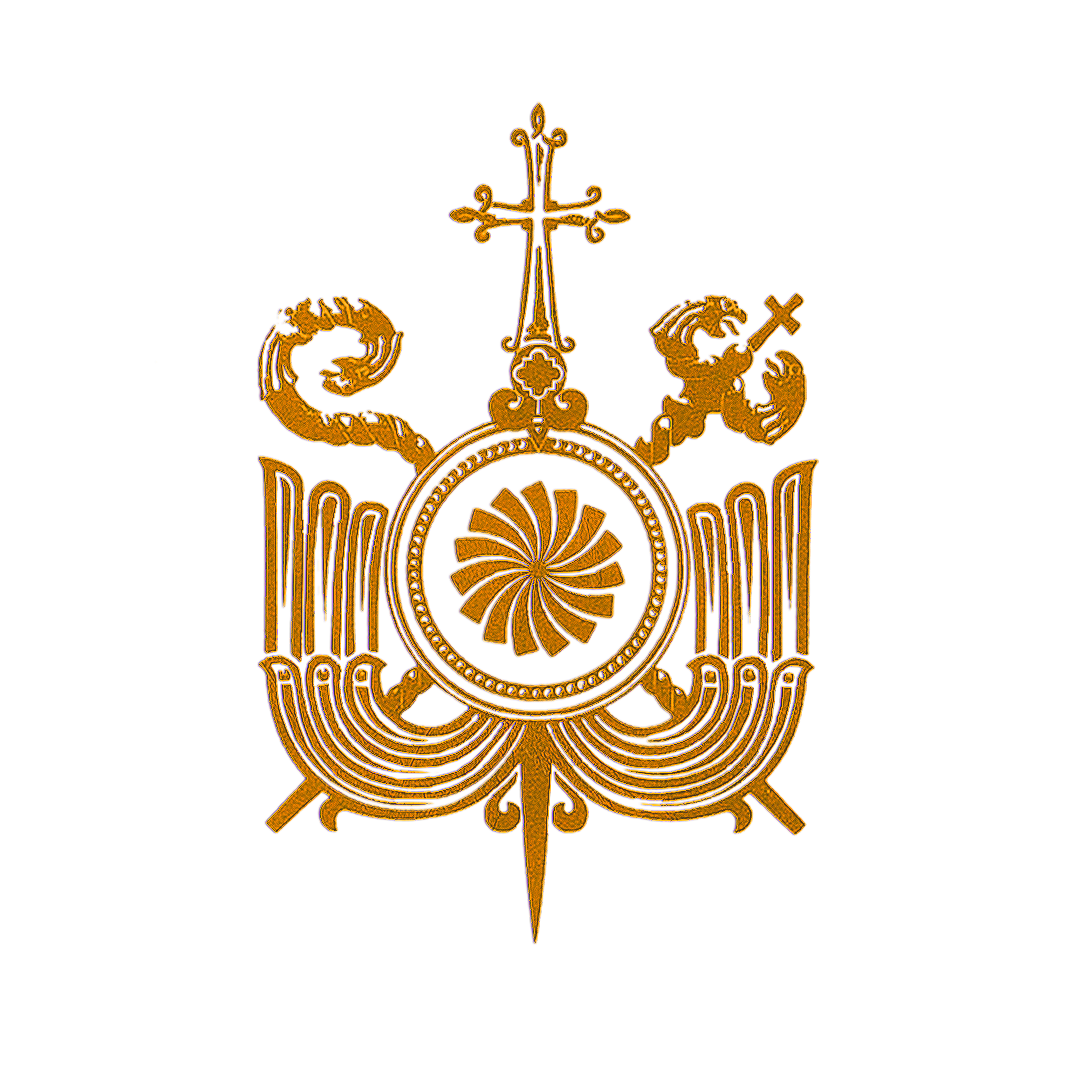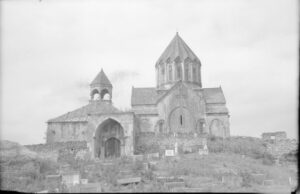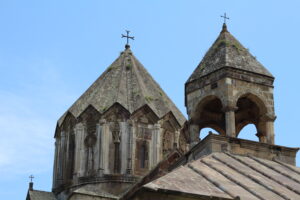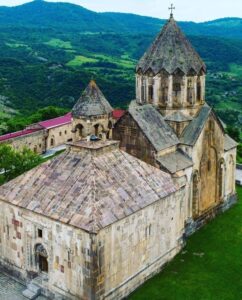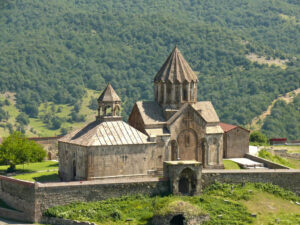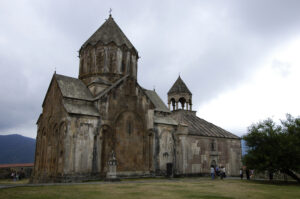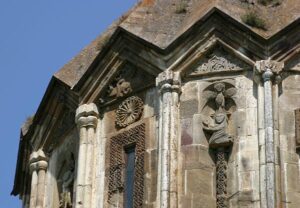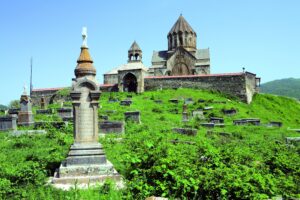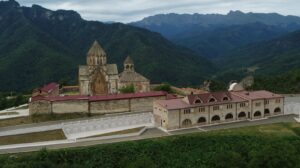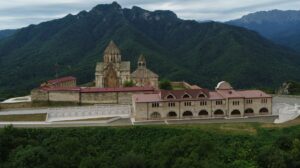Gandzasar
Martakert Province, village Vank
Gandzasar Monastery is one of the wonders of Artsakh. Situated in the Great Arank region of the state of Artsakh, on a promontory high above the west bank of the Khachen River, it overlooks the scenic village of Vank in the Martakert district.
The monastery was built on the site of an ancient church, as evidenced by the khachkars (stone crosses) centuries older than the monastic complex. Reference to the ancient church is also found in the records of the Church Council of 949 convened by Catholicos Anania in the Khachen village of Aghvank.
Gandzasar is the repository of many holy relics, including the head of John the Baptist, the blood of his father Zachariah, St. Gregory the Illuminator's jaw, and relics from St. Pantalion, St. Minas, St. Merkerios and St. Grigoris. Gandzasar is first mentioned in mid-tenth century writings of Anania Mokatsi. On this site, in 1216, Prince Hasan Jalal Dola of Lower Khachen began the construction of the great cathedral of Gandzasar. The vestibule was built by his wife Mamkon and his son Atabeg Ivani which is attached to the Church of St. John the Baptist.
The church was completed in 1238; however, its consecration was delayed for two years by the Mongol invasions. On the Feast of the Transfiguration, July 22, 1240, the ringing of church bells announced the long-awaited opening of one of medieval Armenia's most important spiritual centers. Catholicos Nerses of Aghvan and the historian Kirakos Gandzaketsi took part in the ceremony. Kirakos wrote that more than 700 clergy were in attendance, one of whom, the historical figure Vanakan Vardapet (1181- 1251) left an inscription on the wall.
The 13th-century Armenian jurist and fable writer Mkhitar Gosh writes that from the day of its founding Gandzasar served as the episcopal see and the site of royal cemetery of the Khachen princely family. The monastery's activities were financed by the Hasan-Jalalian family. The Monastery contained a scriptorium and manuscript repository, where many renowned clergy and religious scholars were educated. The richly illuminated «Gandzasar Red Gospel» (12th-13th cent., 313 pp.) is currently held at the library of the University of Chicago, in the USA.
In the late 14th century, Gandzasar became the see of the Armenian Catholicate of Aghvank, a hereditary post held by the Hasan-Jalalian family. The meliks of Artsakh first conceived their plan for Armenian liberation within the sanctuary of Gandzasar. It was here Catholicos Yesayi Hasan-Jalalian gathered around him the leaders of this movement, and it was here that Israel Ori wrote his famous letter to Tsar Peter I seeking liberation from Persian rule in 1701.
Thus, it was from Gandzasar Monastery that the Armenian people approached the Russian orbit in search of independence. Starting in the early 18th century, the Armenian meliks sent numerous letters from Gandzasar to Russian Tsars in hope of liberation, and in retum, taking up arms under the Russian flag. Gandzasar Monastery continued to play this role until 1813, when Artsakh became a part of the Russian Empire.
In 1815, by decree of the Russian Tsar, the Catholicate of Gandzasar was abolished, and a Metropolitan was created in its place. Afterwards, the spiritual centre and see of Artsakh was moved from Gandzasar to Shushi. Gandzasar Monastery has been widely recognized as a high point in Armenian architecture. Charles DiIly, a professor at the Sorbonne in Paris, was taken with its grandeur after his visit in the early 20th century. During an address delivered on March 6, 1907, he ranked five works of Armenian church architecture among the wonders of the world, as follows: , the Holy Cross Church at Aghtamar, St. Hripsime Church in Vagharshapat, the Gandzasar Monastery, Haghpat Monastery, Mother Cathedral at Ani. And Professor Jacobson of St. Petersburg has written that Gandzasar is a veritable encyclopedia of Armenian church architecture. There are nearly 200 inscriptions on the walls of the Gandzasar Monastery, a chronicle in stone.
This magnificent monastery recommended operations as a spiritual center immediately began after the Artsakh liberation movement.
On October 1, 1989. after a long silence, the chants ofthe Divine Liturgy once again echoed in the main church of the monastery, St. John the Baptist Church. It was an inspiring event for the soldiers fighting to liberate Artsakh. That day the Divine Liturgy was celebrated by the Primate of the newly-established Artsakh Diocese and leader of the freedom movement, Bishop Martirosyan.
Since liberation, there has been significant construction in and around the monastery. A 3,1 km mountain road from the village of Vank to the Gandzasar Monastery was built in 1991, affording regular access to monastery. A 3,5 km water pipeline was laid supplying the monastery with drinking water. The western approach to the monastery was reinforced with a 3-meter high, 96-meter long retaining wall. To restore access to the Monastery, a church graveyard was established in a more tranquil location on the monastery grounds and 286 graves were transferred there.
The monastery walls were completely renovated and covered with tiles. An 88-meter long, 2,5 meter high wall was constructed along the eastern approach to the monastery. The Church has also been renovated. Three walls of the vestibule were entirely restored and the eaves and vault reconstructed. Damaged stones on the outer and inner walls have been replaced, the floor has been replaced, and the damaged stones and engravings of the altar have been restored. The vestibule and the church have been fitted with new windows and engraved wooden doors. The area around the monastery has been landscaped with greenery and footpaths and the monastery's entrances were fitted with new wrought-iron gates. Electricity has been installed throughout the monastery.
Eight historic monastic cells, the office and bedroom of Catholicos Yeremia and the refectory have been entirely renovated and refurbished. The monastic dormitory, destroyed by bombing during the war, was replaced with a newly constructed two-story building, housing a new library. To prepare clergy in the post-Soviet era, a new seminary, 52 m by 11 m, with classrooms, common areas, and living quarters has been constructed along side the monastery.
Bibliography
«Diocese of Artsakh» (2009), Erevan, 411 pp.
